Current as of: May 11, 2025 - 16:28
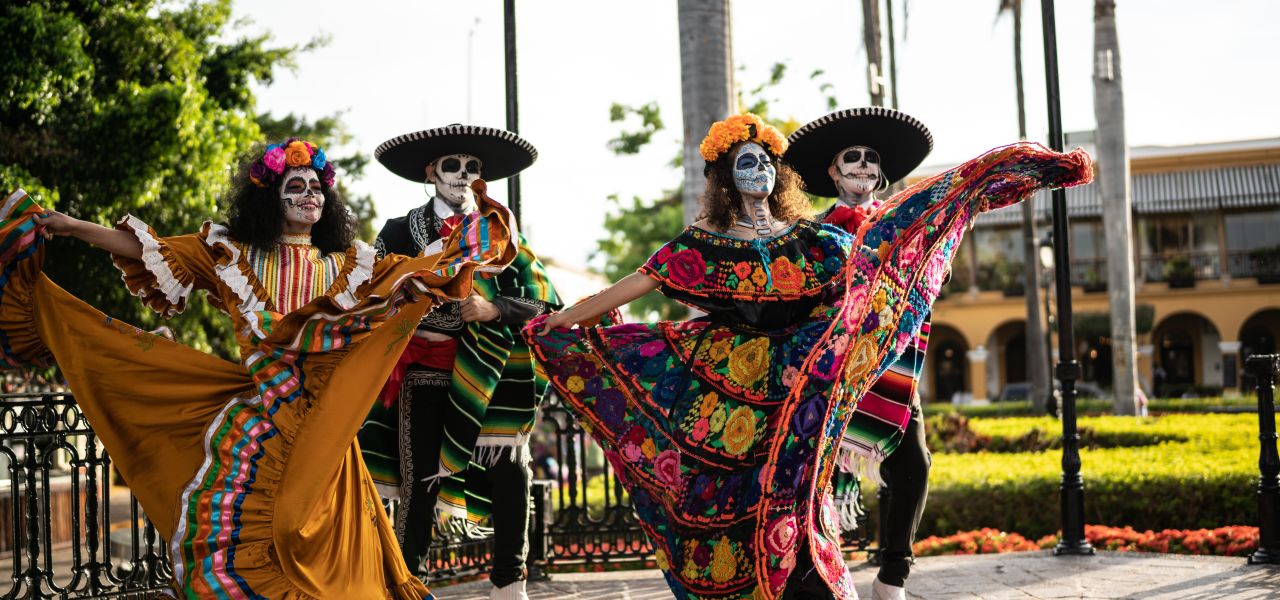
Mexico: Maya, Aztecs & Conquistadors Day of the Dead Festival (Romerillo) Trip Notes
- Ways to Travel: Guided Group
- Destination: Mexico
- Programmes: Culture
-
Activity Level:
2 out of 7 - Easy & Moderate
- 16 Days: Land Only
- Ages: 16+
- Trip Code: AMXR
- Carbon Footprint: 39kg CO2e
Trip Overview
Explore Mexico City, Chichén Itzá and the best bits in between, plus an authentic Día de Muertos experience
Discover Mexico, where jungle temples and abandoned cities make way to colonial towns. This fusion of history has led to a unique culture, encompassing the art of Frida Kahlo and the delicious cuisine of Oaxaca. See it all on a journey from Mexico City to Chichén Itzá, one of the New Wonders of the World. This extra-special adventure, which is one day longer than the standard trip, spends a day celebrating the Day of the Dead, witnessing the traditions and visiting the Chamulan village of Romerillo for an authentic experience of the festivities.
At a Glance
- Accommodation: 15 Classic nights (hotels)
- Travel by private minibus and boat
- Day of the Dead festival departure
- Group normally 5 to 16, plus leader. Minimum age: 16
Highlights
- See the Day of the Dead festivities in Romerillo
- Tour the magnificent historic centre of Mexico City
- Explore Chichén Itzá, one of the New Seven Wonders of the World
- Embark on an immersive cookery course in Oaxaca
- Enjoy a relaxing ride on the canals of Xochimilco
Is This Trip for You?
This trip is rated Activity Level 2 (Easy & Moderate). For more on our trip gradings, visit our Activity Level Guidelines page.
Journeys: Covering a lot of ground from Mexico City to Cancún does mean there are some long drives, some of which are on winding mountain roads. Many of the drives take between two and six hours, with a maximum drive time of approximately eight hours.
Climate: Some of the trip, in the lowlands of Chiapas and the Yucatan in particular, is likely to be hot and humid, especially in summer (drinking plenty of water and dressing in loose cotton clothing will help).
Fitness: Walking city tours and visits to various pre-Hispanic sites mean a fair amount of time on our feet. Many of the areas visited are at high altitude and some short walks (normally one to three hours) are planned. A reasonable level of fitness is recommended.
Swimming: This trip includes a water-based excursion on the Xochimilco canals, where local safety standards may differ from those you are used to. There are unlikely to be personal flotation devices (ie lifejackets or buoyancy aids) available for you to use. If you cannot swim, you should not take part in this activity/excursion. If you are concerned about taking part in this activity, please discuss with your tour leader at the start of the trip so they can make alternative arrangements.
Adult min age: 16
Min group size: 5
Max group size: 16
Itinerary

Land Only
- Start City: Mexico City
- End City: Cancún
Land Only Itinerary
Welcome to Mexico City, a pulsating capital that would take a lifetime to fully explore (though we see some of the many highlights over the next couple of days). We gather at the hotel today, with a welcome meeting this evening: the perfect opportunity to get to know each other a little and ask any questions you may have.
Accommodation: Hotel Royal Reforma/Hotel Histórico Central (or similar)
Those on the group flights normally arrive in Mexico City in the evening. Land only passengers can arrive at any time.
Accommodation: Hotel Royal Reforma (or similar)
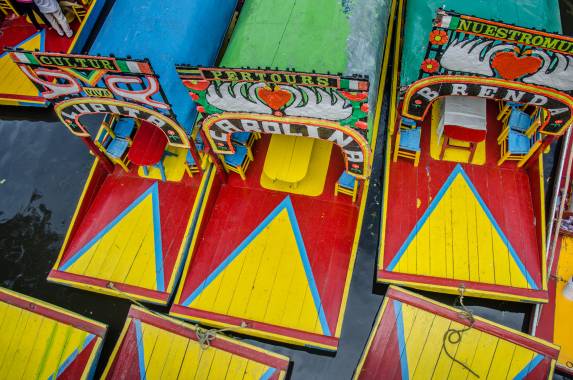
Explore the bohemian side of Mexico City. We start by visiting quaint Coyoacán (meaning place of coyotes) with its pebbled streets, colonial churches, bustling little markets and quiet squares. This area was inhabited before the arrival of the Spanish, and it is said conquistador Hernán Cortés made this the first capital of New Spain.
Next, we head to Casa Azul (visit subject to availability), where artist Frida Kahlo was born, grew up and, eventually, lived with her muralist husband, Diego Rivera, until she died in 1954 at the age of 47. Now a museum, the cobalt-blue colonial house, set around a luxuriant garden, showcases the collections and personal effects of the two great artists and provides a window into the life of affluent Mexican bohemians in the first half of the 20th century.
Finally, enjoy a ride on a pre-Hispanic boat along the Xochimilco canals. These scenic waterways were used by the Aztecs and today see us enjoying a journey past floating gardens and kitchens selling local food. Return to our hotel in the late afternoon.
Accommodation: Hotel Royal Reforma/Hotel Histórico Central (or similar)
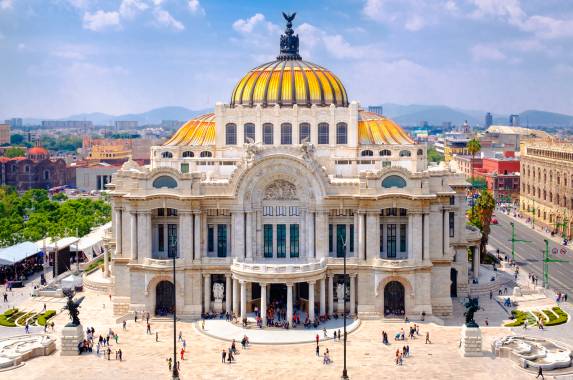
Discover the capital city today. We begin in the historic centre on a walking tour, starting in the main square, known as the Zócalo, but officially named the Plaza de la Constitución. It was an important gathering place for the Aztecs, and remains so in modern Mexico, often hosting book fairs and concerts. On the north side of the Zócalo is the Cathedral Metropolitana, the largest cathedral in the Americas. It was constructed over an Aztec temple, the Templo Mayor, as a sign the Spanish were now in power.
Our walking tour finishes outside the Palacio de Bellas Artes. Construction of this massive neoclassical building began in 1904, on the remains of the Santa Isabel convent, under the Italian architect Adamo Boari. It has an art nouveau style and its facade is made of marble from Carrara.
Next, we visit the Museum of Anthropology, which has an impressive collection of artefacts from the many civilisations of Mexico and provides us with an in-depth insight into the country.
We finish at Chapultepec Castle, home to the National Museum of History, which contains collections throughout the centuries and the declaration of independence of the Mexican empire, signed in 1821.
Accommodation: Hotel Royal Reforma/Hotel Histórico Central (or similar)
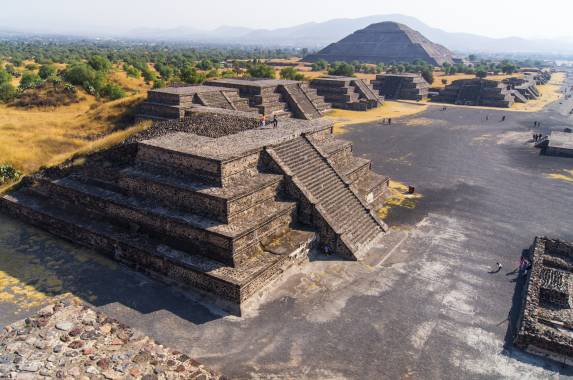
Transfer (1hr 10min) to the ancient city of Teotihuacán, which reached its zenith around 1,000 CE when it was the sixth biggest city in the world with a population of about 125,000-250,000. Among the avenues and structures here are the pyramids of the Sun and the Moon, the third and fourth largest pyramids in the world.
After, we drive (2hr 25min) to Puebla de los Angeles, the City of Angels, so called because of a legend that claims angels came down from heaven to place the cathedral bells in the towers when builders were unable to do so. The colonial city is known for its traditions, especially its handicrafts, including blue-and-white pottery known as talavera, while the local cuisine is considered among the best in Mexico. If you’d like to watch artisans create their pieces in a talavera factory, speak to your sales representative about joining an optional visit (payable locally).
Accommodation: Hotel Colonial Puebla (or similar)
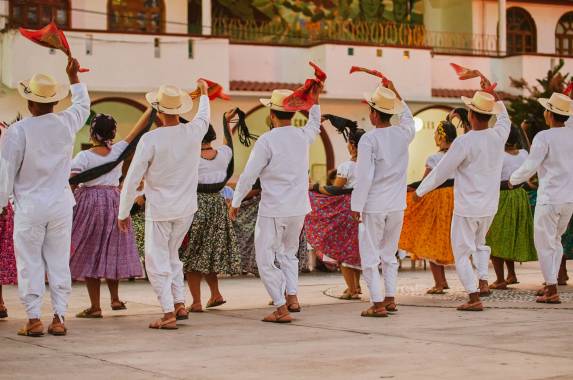
Spend this morning exploring Puebla, which has been named a World Heritage site for its colonial architecture. We visit the Patio de los Azulejos and the Ex-Convent of Santa Rosa, both of which provide classic examples of how talavera tiles were incorporated into buildings, inside and out.
After, we drive (about 5hr 20min) to Oaxaca, another World Heritage city. With a colonial centre of shaded pedestrian streets, indigenous traditions and a creative atmosphere, Oaxaca has attracted and inspired artists and artisans alike.
The city has such sights as the beautiful zócalo (main square), the cathedral and the vast Convento de Santo Domingo, along with museums, fascinating markets and charming inns.
Accommodation: Casa Conzatti/Angel Inn (or similar)
Oaxaca is possibly the most celebrated region in Mexico for its cuisine and we get more acquainted with an authentic cooking class.
The experience starts with an exploration of a local market with our tour leader, in which we pick up ingredients for the meal. Then, we drive to our rustic kitchen, where we are taught to cook a full Mexican menu, including tortillas, a main, and dessert, from a Zapotec cook. We take turns to prepare the dishes, sharing the stations and working together. After, we tuck into our delicious creations!
The afternoon is free to wander around Oaxaca on your own.
Accommodation: Casa Conzatti/Angel Inn (or similar)
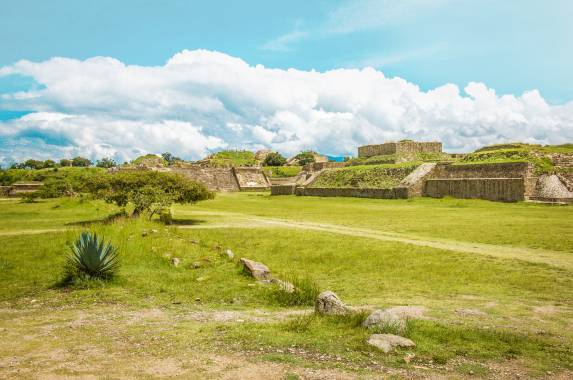
Our next exploration of Mexican history takes us to the Zapotecan site of Monte Albán. While the name dates to a 16th-century Spanish landowner, previous names come from the Mixtec word Sahandevul, meaning at the foot of the sky, or from the Zapotecan Danibaan, meaning sacred mountain. In 500 BCE, the Zapotecans moved into the Oaxaca region and began the monumental task of levelling the top of a 5,250ft (1,600m) high mountain that intersects and divides three valleys. Here, they built the city of Monte Albán with a maze of subterranean passageways, rooms, drainage and water-storage systems.
We then transfer (30 minutes) to the small village of San Antonio Arrazola, where the local population are known for creating fantastical creatures called alebrijes from wood or papier-mâché.
We later return to Oaxaca and explore the cobbled streets, vibrant squares and churches of the historic city. We also visit the Museum of Cultures Santo Domingo.
Accommodation: Casa Conzatti/Angel Inn (or similar)
A short distance from Oaxaca is Teotitlán del Valle, a village known for hand-woven rugs and our first stop today.
From here, we continue to a mezcal distillery in Santiago Matatlán to taste the agave-based spirit. Mezcal is produced from the heart of the agave plant and contains more than 40% alcohol! After the tasting, we drive to Tehuantepec, where we spend the night (the total drive time is about seven hours plus stops).
Accommodation: Hotel Calli (or similar)
Today we drive to San Cristóbal (about six hours plus stops), one of the most popular cities in Mexico for visitors. It is filled with cobbled alleyways of whitewashed buildings with red-tiled roofs that lead to plazas and picturesque arcades.
Arriving in the afternoon, we have a short orientation tour of the historic city before checking into our hotel.
Accommodation: Hotel Diego Mazariegos (or similar)
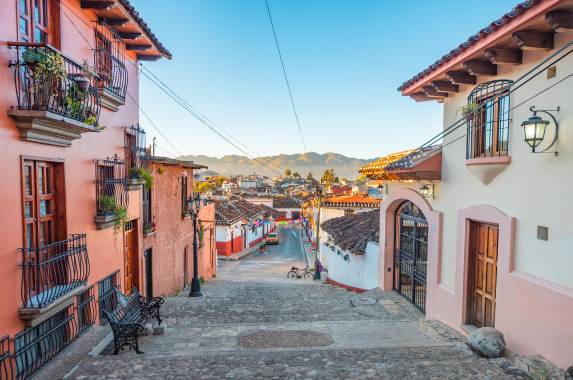
Today is a free day to explore San Cristóbal at your own pace. Wander the colonial streets, take in the lively cafes, or buy handicrafts produced by the local Tzotzil indigenous groups with their different colourful dress. It’s also possible to take an optional boat trip through the Sumidero Canyon and/or visit one of the traditional Maya communities who live in the villages surrounding the city (see money section for prices).
Accommodation: Hotel Diego Mazariegos (or similar)
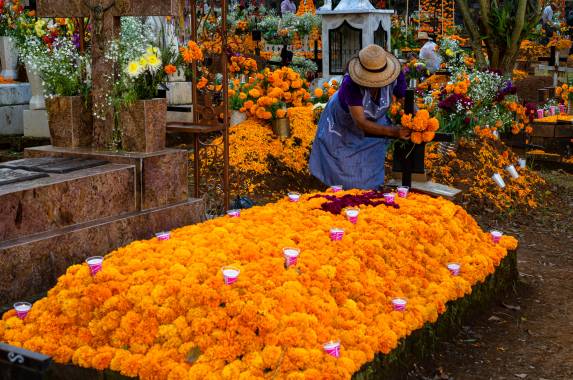
Day of the Dead is possibly the most colourful tribute to human mortality there is. Traditionally, 31 October is for cleaning graves. They are made to look fresh, and planks of wood are placed on top to represent doors.
On 1 November, the festivities begin. Offerings are made to the dead, typically their favourite food and drink, while the ‘doors’ are opened so friends and family can speak with their loved ones. There is mourning but also smiles and laughter – the experience is life affirming and uplifting.
To fully immerse ourselves in the celebrations, we visit cemeteries around San Cristóbal to see altars and tributes and explore markets and bakeries selling Day of the Dead essentials – a great chance to sample specialities only available at this time of year.
We also visit the Chamulan village of Romerillo, where the Day of the Dead traditions haven’t changed in many years – providing us with a very authentic experience. Here, the cemetery is covered with huge blue wooden crosses decorated with chrysanthemums, which makes for a very colourful view.
Accommodation: Hotel Diego Mazariegos (or similar)
Depart San Cristóbal and drive to Palenque, a town named after the impressive ruins nearby. After around 5hr 30min, we stop in Villahermosa, capital of the Tabasco state, before completing the drive (another 2hr 35min) to Palenque. After hotel check-in, those who wish can drive (70 minutes each way) to the Roberto Barrios Waterfalls, which are hidden in the sub-tropical jungle of Chiapas state.
Accommodation: Hotel La Aldea del Halach Huinic (or similar)
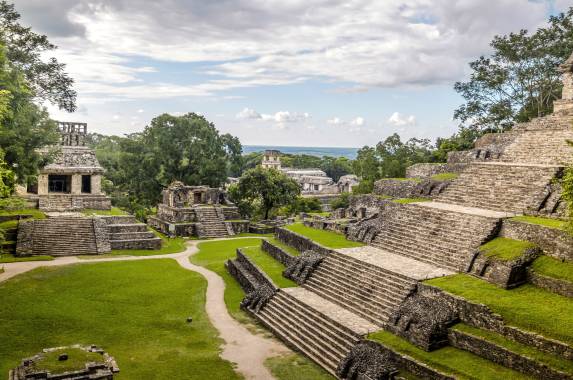
Emerging from the jungles of Chiapas is one of the most impressive ruins in Mexico: the Maya site of Palenque. The temples, sanctuaries and pyramids, with sculptured walls and ceilings, are some of the best-preserved and finest examples of Maya buildings despite the city-state having peaked in the seventh century.
We explore this magnificent site before continuing to the Yucatán Peninsula and the Caribbean town of Campeche (about five hours plus stops).
Yet another World Heritage site, the colonial town has impressive city walls built to protect it from the constant attacks by English and Dutch buccaneers and pirates during the 16th and 17th centuries. We have an orientation tour before dinner.
Accommodation: Hotel Castelmar/Hotel Lopez (or similar)

About two hours’ drive from Campeche is our second Maya site: Uxmal. Quite open, it contrasts the jungle ruins of Palenque we visited yesterday. This site, which dates to the Late Classic era (500 CE to 800 CE), features the Pyramid of the Magician; the Nunnery Quadrangle, which has long, elaborately carved facades; and a ball court, where a traditional ball game was played, sometimes ending in human sacrifice.
Having worked up an appetite, we have lunch at a Maya family restaurant. Here we eat pollo pibil and cochinita pibil (slowly cooked pork and chicken). The meat is roasted for about five hours with achiote paste and wrapped in banana leaves.
After lunch, it’s about a 1hr 20min drive to Mérida, where several colonial buildings, including the cathedral, were built using stones from nearby Maya ruins. Arriving mid-afternoon, we have a walking tour of Mérida, visiting the cathedral, Palacio Municipal, and Casa de Montejo, the birthplace of the city’s founder.
Accommodation: Hotel Caribe (or similar)
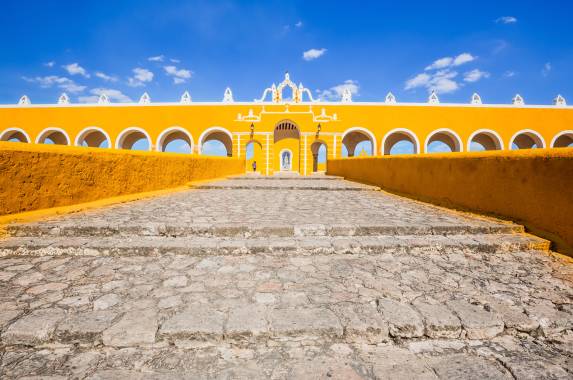
Our first stop, after a 1hr 40min drive, is Izamal, a one-time Maya settlement now marked as a Pueblo Mágico (magic town) by the Mexican government. The town has yellow-and-white buildings and is known for the 16th-century Franciscan monastery built on top of a huge Maya pyramid.
We then continue (1hr 10min) to Yokdzonot cenote, a natural swimming hole with vertical walls decorated with thick mangrove roots. Take a dip in the fresh water or try your hand at the zipline.
From here, we transfer (25 minutes) to Chichén Itzá, the best known and perhaps most impressive of all Maya sites.
Accommodation: Hotel Puerta Chichén (or similar)

Our final day starts with a visit to Chichén Itzá. Having spent the night near the site, we can get in early before the day-trippers arrive from the beach resorts.
Chichén Itzá served as the political and economic centre of the Maya civilisation and thrived from around 600 CE to 1200 CE. The pyramid of Kukulkan, the Temple of Chac Mool, the Hall of the Thousand Pillars and the Playing Field of the Prisoners can still be seen today and demonstrate an extraordinary commitment to architecture, space and composition. The pyramid itself was the last, and possibly greatest, of all Maya pyramids.
This afternoon, we drive about 2hr 30min to Cancún airport, where the tour ends.
Please note: The group transfer back to Cancún is scheduled to align with a chosen flight to London, UK; therefore, you should not book flights leaving before then. Please contact your sales representative for the timings of this flight.
Arrive London
Accommodation
Historic and modern hotels

Staying in a mix of colonial and modern properties, we discover the wide variety of accommodation styles available in Mexico. Typically, these are of a three-star standard and, when we are based in cities, within the historic centres.
Listed below are some of the standout properties we usually use on this trip.
Puebla: Hotel Colonial Puebla (night 4)

Just one block from the zócalo (main square), Hotel Colonial is a historic building dating to 1668. Originally constructed by Jesuits, it hosted travellers as early as the 18th century. Nowadays, its restaurant is particularly renowned – try the mole poblano, a chilli and chocolate sauce that comes from Puebla.
San Cristóbal: Hotel Diego Mazariegos (nights 9-11)
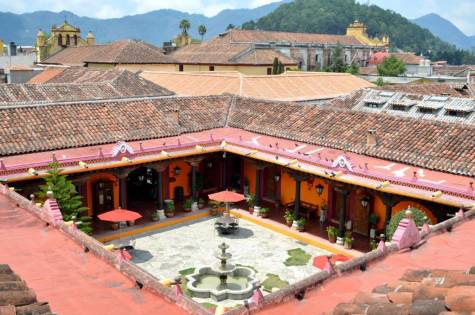
In the historic centre of San Cristóbal, Hotel Diego Mazariegos is within walking distance of the main square and cathedral. The tranquil courtyard, two restaurants and pub provide ample opportunities to relax and refuel after a busy day exploring.
Palenque: Hotel La Aldea del Halach Huinic (night 12)
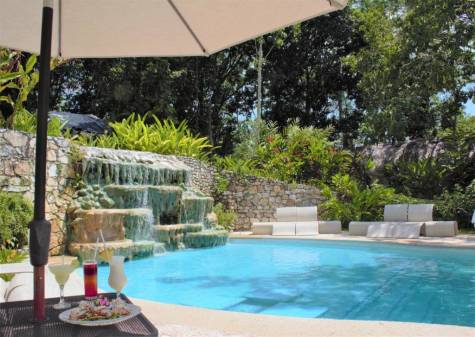
Set in tropical gardens on the outskirts of Palenque National Park, La Aldea del Halach Huinic provides a tranquil place to stay. It has been designed to blend with its natural surroundings and reduce its environmental impact. The outdoor pool is a focal point of the property, and all rooms come with a balcony and hammock overlooking the gardens. Keep your eyes peeled for monkeys and toucans!
Worth knowing
- Rooms may vary in size, style and decoration within a property
Single supplement from CAD 1662
Food & Drink
All breakfasts and two lunches are included.
Breakfast generally consists of fruits, cereals, beans and eggs.
For meals not included, budget around 255-340 Mexican pesos (US$15-US$20) for lunch and 255-510 pesos (US$15-US$30) for dinner. A beer costs about 70 pesos (US$4).
There is a lot more to Mexican cuisine than tacos and tortillas and we can discover the wealth of dishes on offer.
In Oaxaca, we attend a cooking class, the exact dishes we learn to cook can vary but generally include tortillas, salsas, mole (chocolate-based savoury dishes) and guacamole. We also learn about Mexican drinks, visiting a mezcal distillery.
Note: Drinking water is provided on the bus from large containers to minimise the amount of single-use plastic bottles used; please bring a refillable bottle with you.
Transport
Transport during this trip is by private minibuses (usually with air conditioning) and boat.
Weather & Seasonality
There is little variation in temperature between seasons on the coast and in the lowland areas. Expect 28C-33C (82F-91F) average daytime maximum and 18C-23C (64F-73F) nighttime minimum. On the coast, the heat and humidity are moderated by sea breezes, but inland it is likely to be quite humid.
In the hills, the temperatures are moderated by the altitude, and there is more seasonal variation. Between November and February, the daytime maximum is around 20C (68F), rising to 27C (81F) in summer. Nights are much cooler, around 6C (43F) in winter and 12C (54F) in summer. Please note, it can be surprisingly cold in the highlands on winter nights.
The wet season is from June to October, when it normally rains on average one day in three. The rains tend to be short and heavy, alternating with pleasant clear spells. During the other months, rain is much less likely, but there is the chance of an occasional storm at almost any time.
Joining Instructions
Key information
Recommended arrival time: You can arrive at any time today. There will be a welcome briefing in the evening, but if you miss it the leader will update you separately.
Airport: Aeropuerto Internacional Benito Juárez, Mexico City (MEX)
Getting to the start hotel
The start hotel is approximately 50 minutes’ drive from the airport. We provide one group arrival transfer from the airport, which is timed to coincide with the arrival of a chosen flight from London, UK. You may join this transfer at no extra cost, provided you can be at the airport before the transfer leaves. Speak to your sales representative for the group arrival transfer times or to arrange a private transfer.
If you would like further information on joining this trip, please speak to your sales representative.
Catching your return flight
The last night of the trip is spent in Chichén Itzá and the tour finishes in Cancún. The group transfer back to Cancún is scheduled to align with a chosen flight to London, UK; therefore, you should not book flights leaving before then. Please contact your sales representative for the timings of this flight. Free airport departure transfers are only available for return flights departing after the chosen flight route to London – from our Cancún hotel (if you have booked post tour accommodation) to the airport.
Departure tax for international visitors
The state of Quintana Roo charges all international travellers a departure tax. This tax is approximately US$21 per person. The fee can be paid and a receipt obtained by visiting www.visitax.gob.mx/sitio prior to arrival or during the visit. The payment must be verified prior to leaving Quintana Roo. Once travellers have concluded their stay in Quintana Roo, they must show their receipt at the airport checkpoint before boarding. Travellers who do not have a receipt will receive assistance to make the payment at that time.
Full joining instructions including local emergency numbers will be sent to you as part of our Final Joining Instructions. If you do not receive these at least a week before departure, or require them earlier please contact our office or your travel agent.
Location start: Mexico City
Location end: Cancún
What To Take
Essential Equipment
- Sunglasses
- Sunhat
- Sunscreen
- Rain poncho or lightweight waterproof jacket
- Warm sweater
- Swimwear
- Shorts
- Sturdy walking shoes for ruins
- Long trousers (pants)
- Lightweight long‐sleeve shirts
- Insect repellent
- Refillable water bottle
Please note, dress is fairly conservative. Women do not normally wear shorts in the towns and men should always wear a shirt or T‐shirt.
Please note: The Mexican government has banned e-cigarettes and related products. Please ensure you do not pack these in your luggage. You are also only permitted to enter the country with one portable computing device (ie laptop, digital notebook or iPad) without incurring an import fee.
Optional Equipment
- Umbrella
- Binoculars
- Headtorch (head lamp)
- Small backpack for walks/ruins visits
- Universal sink plug
- Camera and accessories (if not using your phone for photos)
Please note: Professional photographic and video equipment (tripod, pro lenses, etc) are prohibited in Chichén Itzá without pre-approved authorisation (and additional pre-paid fees). Cameras capable of shooting 150 megapixels or more and drones are completely prohibited.
Practical Information
Visa
Mexico
Visa requirements often change and it is your responsibility to obtain any required visas for this trip. Therefore, we recommend that you check with the nearest embassy or consulate of your chosen destination(s), including any countries you may be transiting or transferring through.
Some local governments provide guidance on what visas their citizens need. To help, we’ve gathered a selection of useful links below.
- Australia: www.smartraveller.gov.au/destinations/americas/mexico
- Canada: www.travel.gc.ca/destinations/mexico
- United Kingdom: www.gov.uk/foreign-travel-advice/mexico/entry-requirements
- USA: www.travel.state.gov/content/travel/en/international-travel/International-Travel-Country-Information-Pages/Mexico.html
If you are travelling via the USA and are eligible to transit under the Visa Waiver Program, you are required to register in advance for an ESTA (Electronic System for Travel Authorization). There is a US$21 charge, which is only payable online. Please see our website www.exodus.co.uk/usvisa for further information.
Please note, not all nationalities have the same eligibility for travel to or transit via the USA, and you may not be covered by the visa waiver program. Regulations stipulate that any person who has travelled to Iran, Iraq, Libya, North Korea, Somalia, Sudan, Syria or Yemen since March 2011, or have dual nationalities of these countries, may no longer qualify. In addition, if you have travelled to Cuba since 12 January 2021 you will not be eligible for the visa waiver program and should instead apply for a visa.
If you are in doubt of your eligibility, please check the visa requirements with your local US embassy.
Vaccinations and Health
Mexico
There are no required vaccinations. However, you may want to consider vaccinations for hepatitis A, typhoid, tetanus and rabies. Please confirm with your doctor or travel clinic.
The risk of malaria is slight but you may wish to consult your doctor or travel clinic for further advice. Additionally, dengue, zika and chikungunya are known risks in places visited on this trip. All are spread by biting mosquitoes. There is currently no vaccine or prophylaxes available, and therefore the best form of prevention is to avoid being bitten.
Local Time
Mexico's time zone: America/Mexico_City (UTC -06:00)
Electricity
Mexico's electricity: Plug types A (two flat pins) and B (three pins: two flat, one round) – 127V, 60Hz

Money
Mexico's currency: Mexican peso (MXN)
ATM Availability
ATMs are available in most major towns throughout the country, although are more difficult to find in rural areas. A flat fee of up to US$3 and a small commission usually applies with debit card withdrawals. Credit card withdrawals generally attract a one percent charge. Check with your bank before departure to ensure your card will be accepted at ATMs.
Most major credit cards are accepted in larger shops and more expensive restaurants, but their use is not widespread in smaller establishments and so you should ensure you carry adequate supplies of Mexican pesos.
It is easy and convenient to exchange US dollars (cash), although euros, British pounds and other main currencies can be changed fairly easily. Please note that US dollars cannot generally be used to make payments.
Extra Expenses & Spending Money
It is possible to pay for some items in US dollars, including some souvenirs, though in normal shops you need to use Mexican pesos.
Optional excursions (prices subject to change)
Optional activities should be paid in Mexican pesos directly to the tour leader and must be ordered by Day 3.
- Visit to a Talavera workshop in Uriarte: 170 Mexican pesos
San Cristobal
- Sumidero Canyon boat trip: approximately 310 pesos (US$15) per person, transport included as part of main tour
- Visit to local Maya community: approximately 760-1,785 pesos (US$37-US$87) per person, depending on group size. Separate transport included in price
- Local Mayan community visit and Sumidero Canyon boat trip: approximately 1,870- 3,545 pesos (US$90-US$175) per person, depending on group size. Separate transport included in price
Tipping
Although entirely optional, we suggest you budget US$85-US$90 in total to be broken down as follows:
- Approximately 55 pesos (US$3) per day for your tour leader.
- Approximately 35 pesos (US$2) per day for your driver.
- Approximately 100 pesos (US$6) for each local guide used.
Sustainability and Impact
As a certified B Corp, we’re on a mission to improve our social and environmental impact across all our adventures.
We do this through our innovative Thriving Nature, Thriving People plan.
This ‘nature positive’ approach is designed to help nature and communities thrive in harmony though practical solutions, such as reducing carbon and waste on our trips, supporting conservation projects through the Exodus Adventure Travels Foundation, and rewilding 100 square metres for every Exodus traveller.
Important Information
Water safety
This trip includes time by a lake, river or sea, where there may be opportunities to swim. You should always seek local advice before deciding whether to swim. Open-water or wild swim spots should be treated with extreme caution. Information on how to keep yourself safe while swimming is shown here.
Important Information
Your safe participation
When booking this trip, you should be confident in your ability to participate in all activities described in these Trip Notes. If you have any doubt about your suitability, please call us and ask to speak to one of the experts on this itinerary.
Although our leaders are well trained to deal with different capabilities, if they have any concerns about someone’s ability to safely take part in an activity, or their impact on other people’s enjoyment, we authorise them to take necessary action which, in some circumstances, may involve asking someone to miss that activity.
By booking this trip you agree to our Booking Conditions which clearly state that our leaders have the authority to do this. In these rare instances we will ensure anyone sitting out is safely provided for and offered alternative options where possible. Refunds will not be provided for activities missed and customers may be liable for additional costs incurred.
Seatbelts
All vehicles used by us should be equipped with working seatbelts, except where approved by us based on the vehicle type or journey. Wherever seatbelts are available, we require our customers to use them for their own safety, even where it may not be a legal requirement.
How to Book
- Check availability: Go online to check availability, or contact us by phone or email.
- Secure your place: You can provisionally hold a place on this trip, usually for between three and seven days.
- Complete your booking and payment
When you’re ready to book, go to our website for online bookings, book over the phone or you can complete a booking form (available online or on request by calling us). We accept all major credit and debit cards, or you can pay be cheque.
After booking
You will receive your booking confirmation letter and invoice, which includes extra information and guidance about your travel arrangements.
Full joining instructions, including local emergency numbers and details of how to reach the start point, will be sent to you approximately two to three weeks prior to departure. If you do not receive these at least a week before departure, or require them earlier, please contact our office or your travel agent.
Trip Note validity
These Trip Notes are valid from the “Current as” date on page one. They will occasionally be updated after booking and before departure; if there are any updates that significantly impact the inclusions or itinerary, customers will be written to separately. They will also receive a link to the most up-to-date Trip Notes with their Final Joining Instructions before travelling.
The information in these Trip Notes is given in good faith. Where differences exist between the Trip Notes and our current brochure or website, the Trip Notes supersede the brochure and website. All holidays can be subject to unexpected changes; to enjoy them you should be prepared to be flexible where necessary. Occasionally, it may not be possible to follow the itinerary as planned. This may be for a variety of reasons – climatic, political, physical or other. In these circumstances we will make the best-possible alternative arrangements that maintain the integrity of the original itinerary.
Licensing
Exodus is fully licensed and bonded as a tour operator. We hold Air Traffic Organisers Licence (ATOL) number 2582, issued and bonded with the Civil Aviation Authority (CAA). We are also bonded to the International Air Transport Association (IATA) and we are members of the Federation of Tour Operators (FTO) and ABTA – The Travel Association. This means you can book your Exodus holiday with confidence, as all money paid to us for your trip is fully protected.